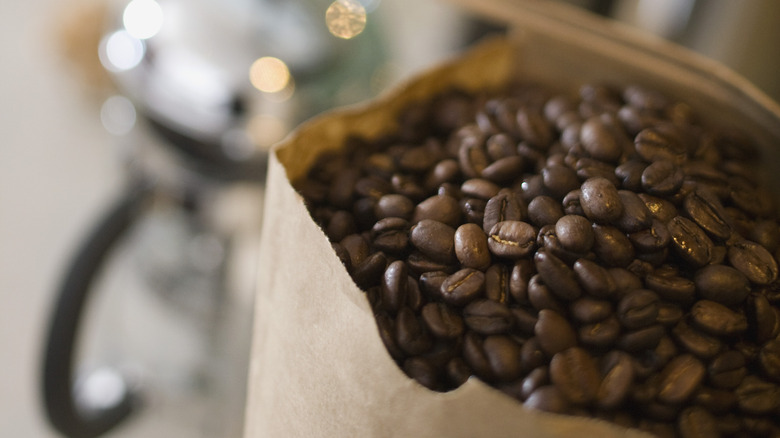Here's The Science Behind Why Coffee Bags Have Holes
Is making coffee first thing part of your morning ritual? It is for many people. In fact, about 62% of adult Americans say they drink coffee every day, according to a National Coffee Data Trends report. Hearing your coffee maker start before smelling freshly brewed coffee can be invigorating and a great way to kickstart the day. That deep, delicious aroma goes a long way in helping you wake up before the coffee even touches your lips and can set the tone for your day.
But have you ever noticed the bag your coffee comes in? Whether you buy a big-name brand, like Starbucks, or a locally made coffee, ground coffee, or whole bean, the bags most likely have some similarities. For one, they will have tabs or some type of tape or zipper to help you reseal the bag after it's been opened. This helps to keep the coffee fresh between uses. The coffee bag will also almost always have holes, but why? There's a good reason for them.
Those holes keep your coffee fresh
Many people think the holes in coffee bags are there to allow the coffee aroma out. That is a nice perk, but there's a more scientific use for those holes — they help keep your coffee fresh. You may be thinking that seems counter-productive since holes can let air in, and air makes food go bad faster. The holes in coffee bags, though, actually keep coffee from going stale too fast.
When coffee beans are roasted, they release carbon dioxide, which can cause the bag to inflate like a balloon if it has no way to escape. This can lead to the bag bursting or coffee beans becoming stale due to excess carbon dioxide exposure. By having small holes in the coffee bag, the carbon dioxide can escape, but air is prevented from entering the bag. This helps to maintain the freshness and flavor of the coffee beans.
Valves get the job done, too
Some coffee bags may also have a one-way valve rather than holes, which functions in a similar way to the holes by allowing carbon dioxide to escape. If your bag has this valve, you can use it to keep air out of your coffee. After you've opened the bag, you can close it back by sealing it with the tabs or tape that is provided. Then, squeeze the bag, and air will leave via the valve.
It's important to note that coffee beans can go bad over time, even when you keep them in their original bag. To help them last longer, you should store opened bags of coffee grounds in an opaque, airtight container and place it in a dark, cool place. After all, light and heat can make whole coffee beans or ground coffee go bad faster. For the freshest coffee, you should use your grounds within two weeks of opening the bag.


